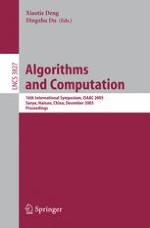2005 | Book
Algorithms and Computation
16th International Symposium, ISAAC 2005, Sanya, Hainan, China, December 19-21, 2005. Proceedings
Editors: Xiaotie Deng, Ding-Zhu Du
Publisher: Springer Berlin Heidelberg
Book Series : Lecture Notes in Computer Science
